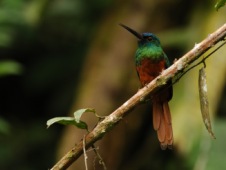
The Ecuador–Peru East Andes Endemic Bird Area (EBA) is defined by the overlapping distributions of 17 restricted-range species. The EBA is estimated to cover 28,000 km2, within which conservation efforts must be targeted: a network of 18 Important Bird and Biodiversity Areas has been identified which holds all 17 species.

The Ecuador–Peru East Andes Endemic Bird Area (EBA) is defined by the overlapping distributions of 17 restricted-range species—species whose individual breeding ranges are smaller than 50,000 km2. The key habitats of this EBA are tropical montane and lowland evergreen forest, which are threatened by agriculture, logging and conversion to pastureland (Stattersfield et al. 1998). The size of this EBA is estimated to be 28,000 km2, a large area in which conservation efforts must be targeted in order to conserve the key species. A network of 18 Important Bird and Biodiversity Areas (IBAs) has been identified in Peru and Ecuador which holds all 17 of the restricted-range species, such as the globally threatened White-necked Parakeet Pyrrhura albipectus, Coppery-chested Jacamar Galbula pastazae and Bicoloured Antvireo Dysithamnus occidentalis (all Vulnerable, BirdLife 2004; see figure). The distributions of many restricted-range species are still poorly known and the boundary of this EBA is necessarily approximate. However, the conservation of this IBA network will go far towards protecting these forests and their unique birds.
Related Species
Links
References
Compiled: 2004
Recommended Citation:
BirdLife International (2004)
Important Bird Areas in Endemic Bird Areas: an example from the East Andes.
Downloaded from https://datazone.birdlife.org/sowb/casestudy/important-bird-areas-in-endemic-bird-areas:-an-example-from-the-east-andes on 22/12/2024